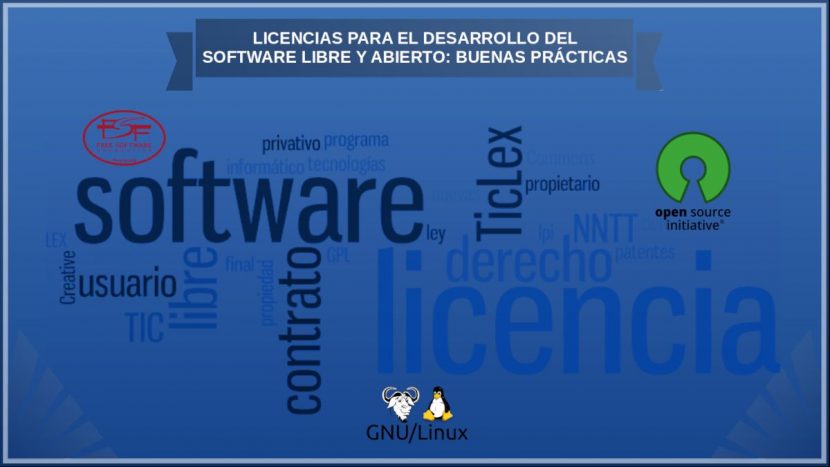
Licenses for the development of Free and Open Software: Good practices
Una software license, broadly speaking, can be described as a contract between author (creator) holder of the rights to use and distribute the product created and the buyer or user thereof.
Hence, all the licenses By definition, they involve the fulfillment of a series of terms and Conditions established by the author (creator). That is, a software license, is nothing more than the right to use of a program under certain accepted parameters.
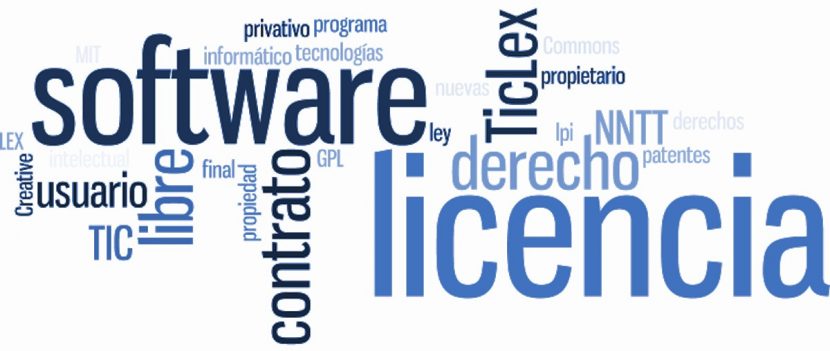
Types of Software Licenses
In some cases, the software licenses usually establish the term of duration you will have the same, since they can be permanent or limited. Another factor that tends to shape their characteristics is the geographic scope, that is, the territory on which they will be applied terms and Conditions established; since each country usually has its own regulations regarding software license.
Licenses they are usually different depending on the type of Software to be covered, that is, each type of License and / or Software defines the other. Among the known Licenses and / or Software we can mention:
Free software products, which are not free or open software
- Abandonware License: It allows the user to make use of the software in a state of abandoned (free of all copyright) public and certified by its author. Facilitating the realization of modifications and distributions with others.
- Careware License: It allows the user the same rights as the Freeware license; but inviting the same to make a donation that is not obligatory or conditioning, in favor of donations to support humanitarian causes, charity and other related campaigns. Generally allowing the user to copy and modify it without restrictions.
- Crippleware License: It allows the user to make use of the software in light versions (lite), that is, with limited functions compared to a full or advanced version.
- Donationware License: It allows the user the same rights as the Freeware license; but inviting the same to make a non-mandatory or conditioning donation, in favor of continuing the development of said application.
- Freeware License: It allows the user the free right to use and copy a software under the terms defined by the author of said program without allowing, under any condition, its modification or sale by third parties.
- Postcardware License: It allows the user the same rights as the Freeware license; but inviting the same to send a postal letter, in a non-mandatory or conditioning way, in favor of the development of the product.
- Shareware License: It allows the user to make use of the software for a limited time or permanently, but with restricted functions. Which can be activated upon payment for a full version.
Proprietary and commercial software products
Un Proprietary software is usually by default a Proprietary and closed software, since its licensing limits the copying, modification and redistribution rights of the same, unless the end user (buyer) pays a certain amount to the author to have the right to do so.
While a Commercial software It has a license that grants by default, the payment of the same to be used. However, there is Commercial software that can be free or proprietaryas it exists Software that is not free and is not commercial.
Furthermore, to a greater extent or totally, software licenses in the field of Proprietary, closed, or commercial software These can be acquired in various schemes, among which we can mention:
- Volume Licensing (Volume)
- Detailed Product Licenses (Retail)
- Electronic licensing by specific product (OEM)
Also, when a Final user usually acquire a Detailed license it is usually known as: End User License Agreement (EULA) o End User License Agreement (EULA). In English it is usually called End User License Agreement (EULA).
Other types of Software Licenses
- From public domain: That which does not include elements of Copyright and allows the use, copying, modification or redistribution for profit or not.
- Copy left: That used in Free Software products, whose distribution terms do not allow redistributors to add any additional restrictions when they redistribute or modify it, so that the modified version must also be free.
- From semi free software: The one used in products that are not Free Software, but authorizes the use, copying, distribution and modification for non-profit individuals.
Other related definitions
- Patent: It is the set of exclusive rights guaranteed by a government or authority to the inventor of a new product (tangible or intangible) capable of being industrially exploited for the good of the applicant for a limited period of time.
- Copyright or Copyright: Form of protection provided by the laws in force in most countries for authors of original works including literary, dramatic, musical, artistic and intellectual works, both published and pending publication.
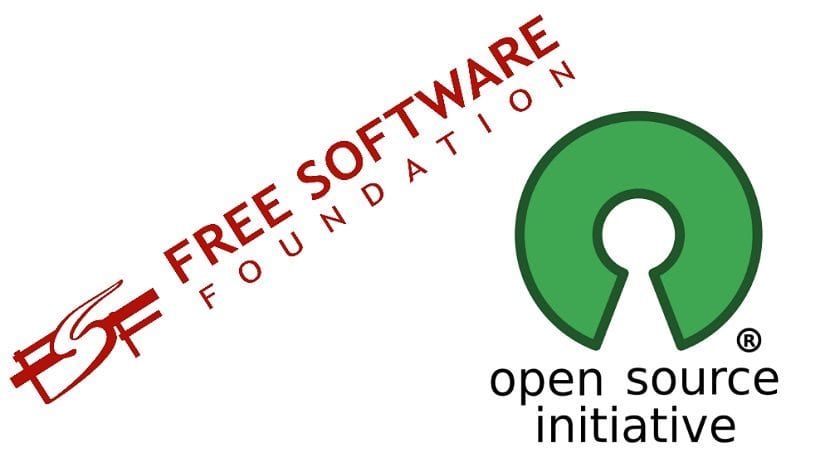
Free Software and Open Source Licenses
Free Software
El Free software is the software that respects the user and community freedom. Broadly speaking, it means that users have the freedom to run, copy, distribute, study, modify and improve the software.
In terms of Free software and especially about Approved licenses (certified / endorsed) the highest authority on this is the Free Software Foundation (FSF). In its section dedicated to Approved licenses and in the section of the Approved licenses o List of Licenses (of Software, Documentation and other works, compatible or not with the General Public License (GPL), and not free), of the GNU Organization are mentioned among many others, those described below:
PREMIUM QUALITY
- The GNU General Public License: Commonly called GPL - GNU, it is used for most GNU programs and for more than half of the Free Software packages. The last one is version number 3, although the previous version 2 of it is still used.
- The GNU Lesser General Public License: Commonly called LGPL - GNU, and is used for some (not all) GNU libraries. The last one is version 3, although the previous version 2.1 of it is still used.
- The Affero General Public License: Commonly called AGPL - GNU, it is based on the GNU GPL, but contains an additional clause that allows users to interact with the licensed program over a network to receive the source code for that program. The latest is version 3.
- The GNU Free Documentation License: Commonly called FDL - GNU or GFDL, it is a form of Copyleft License intended for manuals, textbooks or other documents. The purpose of which is to ensure that everyone has the freedom to copy and redistribute the work, with or without modifications, commercially or non-commercially. The latest is version number 1.3.
Open source
The Software Open Source refers to software whose source code has been put to provision Delivery to Italy takes one or two business days from all over the world and is granted with licenses that facilitate its reuse or adaptation to different contexts. It differs mainly from Free software, since the latter defends the freedom of the users and the community that integrates it, while the Open Source values mainly the practical advantages and not so much the principles of freedom offered by the Free software.
In terms of Open Source and especially about Approved licenses (certified / endorsed) the highest authority on this is the Open Source Initiative (OSI). In its section dedicated to Approved licenses are mentioned among many others, those described below:
PREMIUM QUALITY
- Apache 2.0
- BSD - Clause 3
- FreeBSD - Clause 2
- GPL - GNU
- LGPL - GNU
- MIT
- Mozilla 2.0
- Common development and distribution license
- Eclipse version 2.0
OSI also has a List of OSI Licenses with all approved. Many of these Open Source Licenses are popular, widely used or have strong communities and are also approved by the Free Software Foundation (FSF).
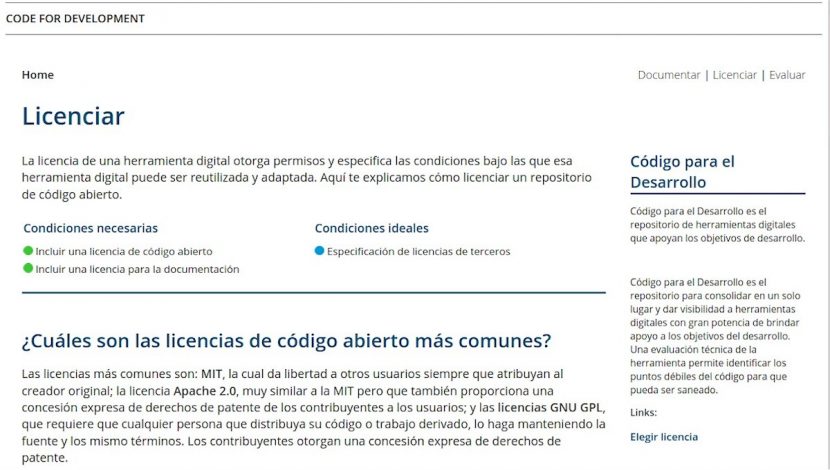
Good practices
For our article, we have taken as an example the Best Practices conceived and disclosed by the "Code for Development Initiative" of the Interamerican Development Bank, on the scope of License Software, which must be taken when developing software products (digital tools), especially free and open.
Among the latests Moravia's compositions good practices offered by them, in terms of License Software are the ones mentioned below:
a) Include an open source license
Citing his recommendation, it is:
"... MIT, which gives freedom to other users as long as they attribute the original creator; the license Apache 2.0, very similar to MIT but also providing an express grant of patent rights from contributors to users; and the GNU GPL licenses, which requires anyone who distributes your code or derivative work to do so while keeping the source and terms the same. Taxpayers grant an express grant of patent rights".
b) Include a license for documentation
Citing his recommendation, it is:
"We recommend the use of creative commons licenses for the licensing of the tools documentation. The CC0-1.0, CC-BY-4.0 and CC-BY-SA-4.0 for example they are open licenses used for non-software material, from data sets to videos. Note that CC-BY-4.0 and CC-BY-SA-4.0 they should not be used for software. For tools developed by the IDB at the moment, we recommend using the Creative Commons IGO 3.0 Attribution-NonCommercial-NoDerivative (CC-IGO 3.0 BY-NC-ND)".
Finally, if you want to read our 2 previous related articles With the theme we leave you the links below: "Good practices to develop free and open Software: Documentation" y "Technical Quality: Good practices in the development of Free Software".
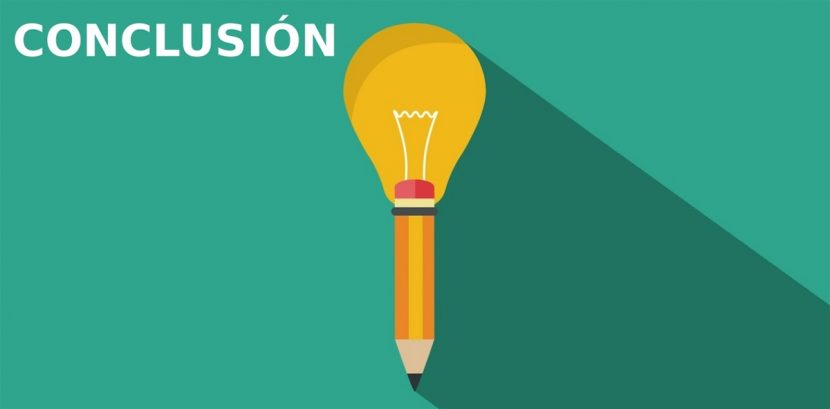
Conclusion
We hope that this "useful little post" the «Buenas prácticas» in the field of «Licencias» to use for him «Software libre y abierto» developed, is of great interest and utility, for the entire «Comunidad de Software Libre y Código Abierto» and of great contribution to the diffusion of the wonderful, gigantic and growing ecosystem of applications of and for «GNU/Linux».
And for more information, always do not hesitate to visit any Online library as OpenLibra y jedit to read books (PDFs) on this topic or others knowledge areas. For now, if you liked this «publicación», don't stop sharing it with others, in your Favorite websites, channels, groups, or communities of social networks, preferably free and open as Mastodon, or secure and private like Telegram.
Or simply visit our home page at DesdeLinux or join the official Channel Telegram from DesdeLinux to read and vote for this or other interesting publications on «Software Libre», «Código Abierto», «GNU/Linux» and other topics related to «Informática y la Computación», and the «Actualidad tecnológica».